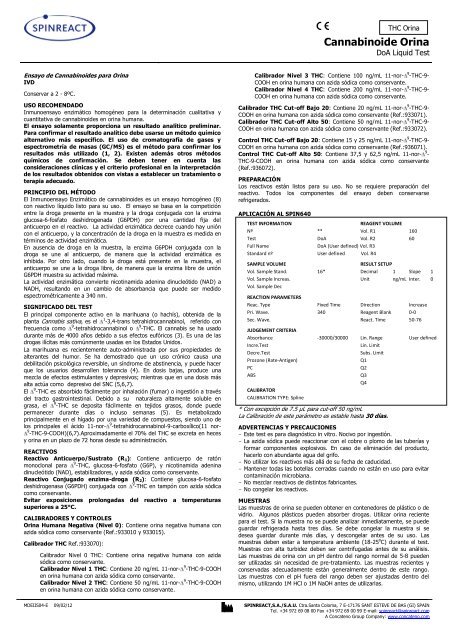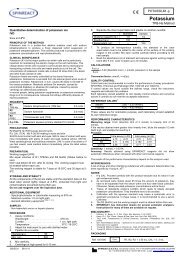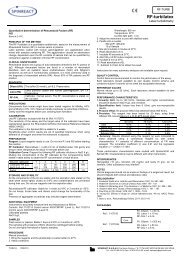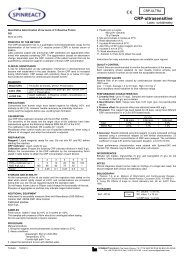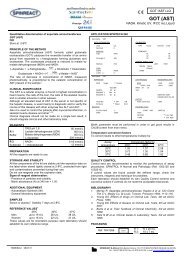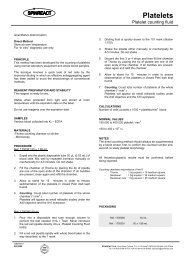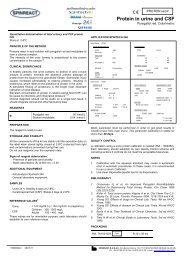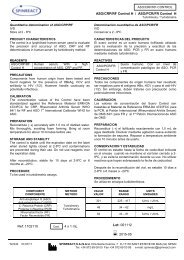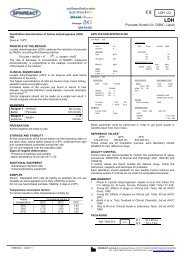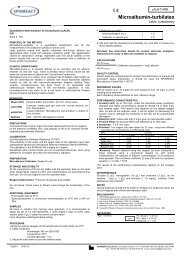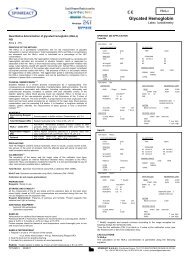Cannabinoide Orina
Cannabinoid Urine - Spinreact
Cannabinoid Urine - Spinreact
You also want an ePaper? Increase the reach of your titles
YUMPU automatically turns print PDFs into web optimized ePapers that Google loves.
THC <strong>Orina</strong><br />
<strong>Cannabinoide</strong> <strong>Orina</strong><br />
DoA Liquid Test<br />
Ensayo de <strong>Cannabinoide</strong>s para <strong>Orina</strong><br />
IVD<br />
Conservar a 2 - 8ºC.<br />
USO RECOMENDADO<br />
Inmunoensayo enzimático homogéneo para la determinación cualitativa y<br />
cuantitativa de cannabinoides en orina humana.<br />
El ensayo solamente proporciona un resultado analítico preliminar.<br />
Para confirmar el resultado analítico debe usarse un método químico<br />
alternativo más específico. El uso de cromatografía de gases y<br />
espectrometría de masas (GC/MS) es el método para confirmar los<br />
resultados más utilizado (1, 2). Existen además otros métodos<br />
químicos de confirmación. Se deben tener en cuenta las<br />
consideraciones clínicas y el criterio profesional en la interpretación<br />
de los resultados obtenidos con vistas a establecer un tratamiento o<br />
terapia adecuado.<br />
PRINCIPIO DEL MÉTODO<br />
El Inmunoensayo Enzimático de cannabinoides es un ensayo homogéneo (8)<br />
con reactivo líquido listo para su uso. El ensayo se basa en la competición<br />
entre la droga presente en la muestra y la droga conjugada con la enzima<br />
glucosa-6-fosfato deshidrogenada (G6PDH) por una cantidad fija del<br />
anticuerpo en el reactivo. La actividad enzimática decrece cuando hay unión<br />
con el anticuerpo, y la concentración de la droga en la muestra es medida en<br />
términos de actividad enzimática.<br />
En ausencia de droga en la muestra, la enzima G6PDH conjugada con la<br />
droga se une al anticuerpo, de manera que la actividad enzimática es<br />
inhibida. Por otro lado, cuando la droga está presente en la muestra, el<br />
anticuerpo se une a la droga libre, de manera que la enzima libre de unión<br />
G6PDH muestra su actividad máxima.<br />
La actividad enzimática convierte nicotinamida adenina dinucleótido (NAD) a<br />
NADH, resultando en un cambio de absorbancia que puede ser medido<br />
espectrométricamente a 340 nm.<br />
SIGNIFICADO DEL TEST<br />
El principal componente activo en la marihuana (o hachís), obtenida de la<br />
planta Cannabis sativa, es el<br />
1 -3,4-trans tetrahidrocannabinol, referido con<br />
frecuencia como<br />
9 -tetrahidrocannabinol o<br />
9 -THC. El cannabis se ha usado<br />
durante más de 4000 años debido a sus efectos eufóricos (3). Es una de las<br />
drogas ilícitas más comúnmente usadas en los Estados Unidos.<br />
La marihuana es recientemente auto-administrada por sus propiedades de<br />
alterantes del humor. Se ha demostrado que un uso crónico causa una<br />
debilitación psicológica reversible, un síndrome de abstinencia, y puede hacer<br />
que los usuarios desarrollen tolerancia (4). En dosis bajas, produce una<br />
mezcla de efectos estimulantes y depresivos; mientras que en una dosis más<br />
alta actúa como depresivo del SNC (5,6,7).<br />
El<br />
9 -THC es absorbido fácilmente por inhalación (fumar) o ingestión a través<br />
del tracto gastrointestinal. Debido a su naturaleza altamente soluble en<br />
grasa, el<br />
9 -THC se deposita fácilmente en tejidos grasos, donde puede<br />
permanecer durante días o incluso semanas (5). Es metabolizado<br />
principalmente en el hígado por una variedad de compuestos, siendo uno de<br />
los principales el ácido 11-nor- 9 -tetrahidrocannabinol-9-carboxílico(11 nor-<br />
9 -THC-9-COOH)(6,7).Aproximadamente el 70% del THC se excreta en heces<br />
y orina en un plazo de 72 horas desde su administración.<br />
REACTIVOS<br />
Reactivo Anticuerpo/Sustrato (R 1): Contiene anticuerpo de ratón<br />
monoclonal para<br />
9 -THC, glucosa-6-fosfato (G6P), y nicotinamida adenina<br />
dinucleótido (NAD), estabilizadores, y azida sódica como conservante.<br />
Reactivo Conjugado enzima-droga (R 2): Contiene glucosa-6-fosfato<br />
deshidrogenasa (G6PDH) conjugada con<br />
9 -THC en tampón con azida sódica<br />
como conservante.<br />
Evitar exposiciones prolongadas del reactivo a temperaturas<br />
superiores a 25°C.<br />
CALIBRADORES Y CONTROLES<br />
<strong>Orina</strong> Humana Negativa (Nivel 0): Contiene orina negativa humana con<br />
azida sódica como conservante (Ref.:933010 y 933015).<br />
Calibrador THC Ref.:933070):<br />
Calibrador Nivel 0 THC: Contiene orina negativa humana con azida<br />
sódica como conservante.<br />
Calibrador Nivel 1 THC: Contiene 20 ng/mL 11-nor- 9 -THC-9-COOH<br />
en orina humana con azida sódica como conservante.<br />
Calibrador Nivel 2 THC: Contiene 50 ng/mL 11-nor- 9 -THC-9-COOH<br />
en orina humana con azida sódica como conservante.<br />
Calibrador Nivel 3 THC: Contiene 100 ng/mL 11-nor- 9 -THC-9-<br />
COOH en orina humana con azida sódica como conservante.<br />
Calibrador Nivel 4 THC: Contiene 200 ng/mL 11-nor- 9 -THC-9-<br />
COOH en orina humana con azida sódica como conservante.<br />
Calibrador THC Cut-off Bajo 20: Contiene 20 ng/mL 11-nor- 9 -THC-9-<br />
COOH en orina humana con azida sódica como conservante (Ref.:933071).<br />
Calibrador THC Cut-off Alto 50: Contiene 50 ng/mL 11-nor- 9 -THC-9-<br />
COOH en orina humana con azida sódica como conservante (Ref.:933072).<br />
Control THC Cut-off Bajo 20: Contiene 15 y 25 ng/mL 11-nor- 9 -THC-9-<br />
COOH en orina humana con azida sódica como conservante (Ref.:936071).<br />
Control THC Cut-off Alto 50: Contiene 37,5 y 62,5 ng/mL 11-nor- 9 -<br />
THC-9-COOH en orina humana con azida sódica como conservante<br />
(Ref.:936072).<br />
PREPARACIÓN<br />
Los reactivos están listos para su uso. No se requiere preparación del<br />
reactivo. Todos los componentes del ensayo deben conservarse<br />
refrigerados.<br />
APLICACIÓN AL SPIN640<br />
TEST INFORMATION<br />
REAGENT VOLUME<br />
Nº ** Vol. R1 160<br />
Test DoA Vol. R2 60<br />
Full Name<br />
DoA (User defined) Vol. R3<br />
Standard nº User defined Vol. R4<br />
SAMPLE VOLUME<br />
RESULT SETUP<br />
Vol. Sample Stand. 16* Decimal 1 Slope 1<br />
Vol. Sample Increas. Unit ng/mL Inter. 0<br />
Vol. Sample Dec<br />
REACTION PARAMETERS<br />
Reac. Type Fixed Time Direction Increase<br />
Pri. Wave. 340 Reagent Blank 0-0<br />
Sec. Wave. React. Time 50-76<br />
JUDGEMENT CRITERIA<br />
Absorbance -30000/30000 Lin. Range User defined<br />
Incre.Test<br />
Lin. Limit<br />
Decre.Test<br />
Subs. Limit<br />
Prozone (Rate-Antigen)<br />
Q1<br />
PC<br />
Q2<br />
ABS<br />
Q3<br />
Q4<br />
CALIBRATOR<br />
CALIBRATION TYPE: Spline<br />
* Con excepción de 7.5 μL para cut-off 50 ng/mL<br />
La Calibración de este parámetro es estable hasta 30 días.<br />
ADVERTENCIAS Y PRECAUCIONES<br />
- Este test es para diagnóstico in vitro. Nocivo por ingestión.<br />
- La azida sódica puede reaccionar con el cobre o plomo de las tuberías y<br />
formar componentes explosivos. En caso de eliminación del producto,<br />
hacerlo con abundante agua del grifo.<br />
- No utilizar los reactivos más allá de su fecha de caducidad.<br />
- Mantener todas las botellas cerradas cuando no están en uso para evitar<br />
contaminación microbiana.<br />
- No mezclar reactivos de distintos fabricantes.<br />
- No congelar los reactivos.<br />
MUESTRAS<br />
Las muestras de orina se pueden obtener en contenedores de plástico o de<br />
vidrio. Algunos plásticos pueden absorber drogas. Utilizar orina reciente<br />
para el test. Si la muestra no se puede analizar inmediatamente, se puede<br />
guardar refrigerada hasta tres días. Se debe congelar la muestra si se<br />
desea guardar durante más días, y descongelar antes de su uso. Las<br />
muestras deben estar a temperatura ambiente (18-25 o C) durante el test.<br />
Muestras con alta turbidez deben ser centrifugadas antes de su análisis.<br />
Las muestras de orina con un pH dentro del rango normal de 5-8 pueden<br />
ser utilizadas sin necesidad de pre-tratamiento. Las muestras recientes y<br />
conservadas adecuadamente están generalmente dentro de este rango.<br />
Las muestras con el pH fuera del rango deben ser ajustadas dentro del<br />
mismo, utilizando 1M HCl o 1M NaOH antes de utilizarlas.<br />
MDEIIS04-E 09/02/12 SPINREACT,S.A./S.A.U. Ctra.Santa Coloma, 7 E-17176 SANT ESTEVE DE BAS (GI) SPAIN<br />
Tel. +34 972 69 08 00 Fax +34 972 69 00 99 E-mail: spinreact@spinreact.com<br />
A Concateno Group Company: www.concateno.com
THC <strong>Orina</strong><br />
<strong>Cannabinoide</strong> <strong>Orina</strong><br />
DoA Liquid Test<br />
La adulteración puede causar resultados erróneos. Si se sospecha de<br />
adulteración de la muestra, se debe obtener una muestra nueva y ambas<br />
muestras deben ser ensayadas.<br />
Manipular todas las muestras de orina como si fueran potencialmente<br />
infecciosas.<br />
MATERIAL ADICIONAL<br />
- Autoanalizador Spin640<br />
- Equipamiento habitual de laboratorio.<br />
CALIBRACIÓN<br />
Para determinaciones cualitativas, el reactivo tiene que ser calibrado con el<br />
calibrador del punto de corte deseado. Para determinaciones semicuantitativas,<br />
el reactivo debe ser calibrado con los 5 puntos de calibración<br />
indicados a continuación.<br />
Niveles Calibrador (ng/mL)<br />
CUALITATIVO<br />
SEMI-<br />
CUANTITATIVO<br />
Niveles Control<br />
(ng/mL)<br />
Cut-off bajo (20) Nivel 0 (0)<br />
Nivel 1 (20)<br />
Nivel 2 (50)<br />
Nivel 3 (100)<br />
Cut-off alto (50) Nivel 4 (200)<br />
Control - 25% (15)<br />
Control + 25% (25)<br />
Control - 25% (37,5)<br />
Control + 25%(62,5)<br />
INTERPRETACIÓN<br />
Para determinaciones cualitativas, los calibradores de punto de corte (20 o 50<br />
ng/ml) de THC se utilizan como referencia para distinguir muestras positivas y<br />
negativas. Una muestra con un incremento de absorbancia ( mA/min) igual o<br />
mayor que el punto de corte utilizado es considerada positiva. Una muestra<br />
con un incremento de absorbancia ( mA/min) menor que el punto de corte<br />
utilizado es considerada negativa.<br />
Para determinaciones semi-cuantitativas, se requiere una curva de calibración<br />
multi-punto. La concentración de THC en la muestra puede ser estimada en la<br />
curva de calibración.<br />
CONTROL DE CALIDAD<br />
Las buenas prácticas en laboratorio recomiendan el uso de controles para<br />
asegurar el correcto funcionamiento del ensayo.<br />
La curva de calibración puede ser validada con los controles de Nivel Bajo 15<br />
y 25 ng/mL, o Alto 37,5 y 62,5 ng/mL (códigos 936071 y 936072<br />
respectivamente), o bien con Controles comerciales.<br />
LIMITACIONES<br />
1. Un resultado positivo del ensayo sólo indica presencia de 11-nor- 9 -THC.<br />
2. Consultar el “Uso Recomendado” para obtener detalles acerca de los<br />
métodos de confirmación recomendados.<br />
3. El reactivo está diseñado para ser utilizado solamente en orina humana.<br />
BIBLIOGRAFÍA<br />
1. Urine Testing for Drug of Abuse, National Institute on Drug Abuse (NIDA) Research<br />
Monograph 73, 1986.<br />
2. Mandatory Guidelines for Federal Workplace Drug Testing Program, National Institute<br />
on Drug Abuse, Federal Register, vol. 53, No. 69, pp11970 (1988)<br />
3. Marilyn A Huestics, “Marijuana”, in Contemporary Practice in Clinical Toxicology, 2 nd<br />
edition, Leslie M. Shaw, editor-in-chief. AACC, 2000.<br />
4. Nahas, G.G., Cannabis: Toxicological Properties and Epidemiological Aspects, Med J.<br />
Aust., 145:82 (1986)<br />
5. Baselt, R.C.and R.H. Cravey, Disposition of Toxic Drugs and Chemicals in Man, 3 rd<br />
Edition, pp. 780-783, Chicago, IL. Year Book Medical Publishers Inc. 1990.<br />
6. Wall, M.E., D.R. Brine and M. Peres-Reyes, Metabolism of Cannabinoids in Man., in The<br />
Pharmacology of Marijuana, Brande, M.C. and S. Szara, editors, Raven Press, p. 93,<br />
1976.<br />
7. Chiang, C.N., and G. Barnett, Marijuana Pharmacokinetics and Pharmacodynamics, in<br />
Cocaine, Marijuana, Designer Drugs: Chemistry, Pharmacology, and Behavior, Redda.<br />
K.K., C.A. Walker, and G. Barnett, editors, CRC Press, Boca Raton, FL. 1989<br />
8. Rubenstein, K.E., R.S. Schneider, and E.F. Ullman, Homogeneous Enzyme<br />
Immunoassay: A New Immunochemical Technique, Biochem Biophys Res Commun, 47,<br />
846 (1972)<br />
PRESENTACIÓN<br />
Ref.: MD930028<br />
Cont.<br />
R1: 2 x 40 mL<br />
R2: 2 x 15 mL<br />
MDEIIS04-E 09/02/12 SPINREACT,S.A./S.A.U. Ctra.Santa Coloma, 7 E-17176 SANT ESTEVE DE BAS (GI) SPAIN<br />
Tel. +34 972 69 08 00 Fax +34 972 69 00 99 E-mail: spinreact@spinreact.com<br />
A Concateno Group Company: www.concateno.com
THC Urine<br />
Cannabinoid Urine<br />
DoA Liquid Test<br />
Cannabinoid Assay for Urine<br />
IVD<br />
Store at 2 - 8ºC<br />
INTENDED USE<br />
The Cannabinoid Enzyme Immunoassay (EIA) is a homogenous enzyme<br />
immunoassay system intended for use in the qualitative and semi-quantitative<br />
analysis of cannabinoids in human urine.<br />
The assay provides only a preliminary analytical result. A more<br />
specific alternative chemical method must be used in order to obtain<br />
a confirmed analytical result. Gas Chromatography/mass<br />
spectrometry (GC/MS) is the preferred confirmatory method (1, 2).<br />
Clinical consideration and professional judgement should be<br />
exercised to any result, in order to establish the appropriate<br />
treatment or therapy.<br />
PRINCIPLE OF THE METHOD<br />
The cannabinoids immunoassay is a homogeneous enzyme immunoassay (8)<br />
with ready-to-use liquid reagent. The assay is based on competition between<br />
drug in the sample and drug labelled with the enzyme glucose-6-phosphate<br />
dehydrogenase (G6PDH) for a fixed amount of antibody in the reagent.<br />
Enzyme activity decreases upon binding to the antibody, and the drug<br />
concentration in the sample is measured in terms of enzyme activity.<br />
In the absence of drug in the sample,<br />
9 -THC-labelled G6PDH conjugate is<br />
bound to antibody, and the enzyme activity is inhibited. On the other hand,<br />
when free drug is present in the sample, antibody would bind to the free<br />
drug; the unbound<br />
9 -THC -labelled G6PDH then exhibits its maximal enzyme<br />
activity.<br />
Active enzyme converts nicotinamide adenine dinucleotide (NAD) to NADH,<br />
resulting in an absorbance change that can be measured<br />
spectrophotometrically at 340 nm.<br />
SIGNIFICANCE OF THE TEST<br />
The principal, active constituent in marijuana (or hashish), obtained from<br />
Cannabis sativa plant, is the<br />
1 -3,4-trans tetrahydrocannabinol, frequently<br />
referred as<br />
9 -tetrahydocannabinol or<br />
9 -THC. Cannabis has been used for<br />
its euphoric effects for over 4000 years (3). It is one of the most commonly<br />
used illicit drugs in the United States.<br />
Marijuana is frequently self-administered for its mood-altering properties.<br />
Chronic use has been shown to cause reversible psychological impairment, an<br />
abstinence syndrome, and can cause users to develop tolerance (4). At low<br />
doses, it produces mixed depressant and stimulant effects; while at higher<br />
dose it acts as a CNS depressant (5,6,7).<br />
9 -THC is easily absorbed by inhalation (smoking) or ingestion through the<br />
gastrointestinal tract. Due to its highly fat-soluble nature,<br />
9 -THC is readily<br />
deposited in fatty tissues, where it may remain for days or even weeks (5). It<br />
is primarily metabolized in the liver to a variety of compounds, the primary<br />
one being the 11-nor- 9 -tetrahydrocannabinol-9-carboxylic acid (11-nor- 9 -<br />
THC-9-COOH) (6, 7). Approximately 70% of THC is excreted in faeces and<br />
urine within 72 hours of administration.<br />
REAGENTS<br />
Antibody/Substrate Reagent (R 1): Contains mouse monoclonal<br />
antibodies to<br />
9 -THC, glucose-6-phosphate (G6P), nicotinamide adenine<br />
dinucleotide (NAD), stabilizers, and sodium azide as preservative.<br />
Enzyme-drug Conjugate Reagent (R 2): Contains<br />
9 -THC -labelled<br />
glucose-6-phosphate dehydrogenase (G6PDH) in buffer with sodium azide as<br />
preservative.<br />
Avoid prolonged exposures of the reagent at temperatures higher<br />
than 25°C.<br />
CALIBRATORS AND CONTROLS<br />
Negative Human Urine (Level 0): Contains negative human urine with<br />
sodium azide as preservative (Ref.: 933010 o Ref.:933015).<br />
THC Calibrator (Ref. 933070):<br />
THC Calibrator Level 0: Contains human urine with sodium azide as<br />
preservative.<br />
THC Calibrator Level 1: Contains 20 ng/mL 11-nor- 9 -THC-9-COOH<br />
in human urine with sodium azide as preservative.<br />
THC Calibrator Level 2: Contains 50 ng/mL 11-nor- 9 -THC-9-COOH<br />
in human urine with sodium azide as preservative.<br />
THC Calibrator Level 3: Contains 100 ng/mL 11-nor- 9 -THC-9-COOH<br />
in human urine with sodium azide as preservative.<br />
C THC Calibrator Level 4: Contains 200 ng/mL 11-nor- 9 -THC-9-<br />
COOH in human urine with sodium azide as preservative.<br />
THC Calibrator Low Cut-Off 20: Contains 20 ng/mL 11-nor- 9 -THC-9-<br />
COOH in human urine with sodium azide as preservative (Ref.: 933071).<br />
THC Calibrator High Cut-Off 50: Contains 50 ng/mL 11-nor- 9 -THC-9-<br />
COOH in human urine with sodium azide as preservative (Ref.: 933072).<br />
THC Control Low Cut-Off 20: Contains 15 and 25 ng/mL 11-nor- 9 -<br />
THC-9-COOH in human urine with sodium azide as preservative (Ref.:<br />
936071).<br />
THC Control High Cut-Off 50: Contains 37,5 and 62,5 ng/mL 11-nor- 9 -<br />
THC-9-COOH in human urine with sodium azide as preservative (Ref.:<br />
936072).<br />
PREPARATION<br />
The reagents are ready to use. No reagent preparation is required. All<br />
assay components should be stored refrigerated when not in use.<br />
SPINT640 APPLICATION<br />
TEST INFORMATION<br />
REAGENT VOLUME<br />
Nº ** Vol. R1 160<br />
Test DoA Vol. R2 60<br />
Full Name<br />
DoA (User defined) Vol. R3<br />
Standard nº User defined Vol. R4<br />
SAMPLE VOLUME<br />
RESULT SETUP<br />
Vol. Sample Stand. 16* Decimal 1 Slope 1<br />
Vol. Sample Increas. Unit ng/mL Inter. 0<br />
Vol. Sample Dec<br />
REACTION PARAMETERS<br />
Reac. Type Fixed Time Direction Increase<br />
Pri. Wave. 340 Reagent Blank 0-0<br />
Sec. Wave. React. Time 50-76<br />
JUDGEMENT CRITERIA<br />
Absorbance -30000/30000 Lin. Range User defined<br />
Incre.Test<br />
Lin. Limit<br />
Decre.Test<br />
Subs. Limit<br />
Prozone (Rate-Antigen)<br />
Q1<br />
PC<br />
Q2<br />
ABS<br />
Q3<br />
Q4<br />
CALIBRATOR<br />
CALIBRATION TYPE: Spline<br />
*With exception of 7.5 μL for cut-off 50 ng/mL<br />
This parameter calibration is stable for 30 days.<br />
WARNING AND PRECAUTIONS<br />
- This test is for in vitro diagnostic use only. Harmful if swallowed.<br />
- Reagents used in the assay contain sodium azide that may react with<br />
lead or copper plumbing to form potentially explosive metal azide. When<br />
disposing such reagents or wastes always flush with a large volume of<br />
water to prevent azide build-up.<br />
- Do not use the reagents beyond their expiration dates.<br />
- Keep all containers closed when not in use to avoid microbial<br />
contamination.<br />
- Do not mix reagents from different manufacturers.<br />
- Do not freeze reagents.<br />
SPECIMEN COLLECTION<br />
Urine samples may be collected in plastic or glass containers. Some<br />
plastics may adsorb drugs. Use a fresh urine specimen for the test. If the<br />
sample can not be analyzed immediately, it may be stored refrigerated for<br />
up to 3 days. For longer storage keep the sample frozen and then thaw<br />
before use. Samples should be bought to room temperature of 18-25 o C for<br />
testing. Samples with high turbidity should be centrifuged before analysis.<br />
Urine samples within the normal pH range of 5-8 can be tested without any<br />
pre-treatment. Fresh and properly stored urine samples generally are<br />
within this range. Samples with pH out of the range should be adjusted to<br />
be within this range with 1M HCl or 1M NaOH before testing.<br />
Adulteration may cause erroneous results. If sample adulteration is<br />
suspected, obtain a new sample and both samples should be forwarded to<br />
the laboratory for testing.<br />
Handle all urine specimens as if they are potentially infectious.<br />
INSTRUMENTATION REQUIRED<br />
- Spin640 autoanalizer<br />
MDEIIS04-I 09/02/12 SPINREACT,S.A./S.A.U. Ctra.Santa Coloma, 7 E-17176 SANT ESTEVE DE BAS (GI) SPAIN<br />
Tel. +34 972 69 08 00 Fax +34 972 69 00 99 E-mail: spinreact@spinreact.com<br />
A Concateno Company: www.concateno.com
THC Urine<br />
Cannabinoid Urine<br />
DoA Liquid Test<br />
- Laboratory equipment.<br />
CALIBRATION<br />
For qualitative determinations, the reagent must be calibrated with the<br />
selected cut-off calibrator. For semi-quantitative determinations, the reagent<br />
can be calibrated with a 5 point calibration curve.<br />
Calibrator levels (ng/mL)<br />
QUALITATIVE<br />
SEMI-<br />
QUANTITATIVE<br />
Control Levels<br />
(ng/mL)<br />
Low cut-off (20) Level 0 (0)<br />
Level 1 (20)<br />
Level 2 (50)<br />
Level 3 (100)<br />
High cut-off (50) Level 4 (200)<br />
Control - 25% (15)<br />
Control + 25% (25)<br />
Control - 25% (37,5)<br />
Control + 25%(62,5)<br />
INTERPRETATION<br />
For qualitative determinations, the cut-off calibrator (20 or 50 ng/mL) of THC<br />
is used as a reference for distinguishing positive from negative samples. A<br />
sample with a change in absorbance ( mA/min) equal to, or greater than,<br />
that obtained with the cut-off calibrator is considered positive. A sample with<br />
a change in absorbance value lower than that obtained with the cut-off<br />
calibrator is considered negative.<br />
For semi-quantitative determinations, a calibration curve with multiple<br />
calibrators is required. The concentration of THC in the sample may then be<br />
estimated from the calibration curve.<br />
QUALITY CONTROL<br />
Good laboratory practices recommend the use of control specimens to ensure<br />
proper assay performance.<br />
The calibration curve can be validated with the controls level 15 and 25<br />
ng/mL, or 37,5 and 62,5 ng/mL (Ref. 936071 and 936072, respectively) or<br />
with commercial controls.<br />
LIMITATIONS<br />
1. A positive result from the assay indicates only the presence of 11-nor 9 -<br />
carboxy-∆ 9 -THC<br />
2. Refer to the intended use statement for details of recommended<br />
confirmation testing methods.<br />
3. The test is designed for use with human urine only.<br />
BIBLIOGRAPHY<br />
1. Urine Testing for Drug of Abuse, National Institute on Drug Abuse (NIDA)<br />
Research Monograph 73, 1986.<br />
2. Mandatory Guidelines for Federal Workplace Drug Testing Program, National<br />
Institute on Drug Abuse, Federal Register, vol. 53, No. 69, pp11970 (1988)<br />
3. Marilyn A Huestics, “Marijuana”, in Contemporary Practice in Clinical Toxicology,<br />
2 nd edition, Leslie M. Shaw, editor-in-chief. AACC, 2000.<br />
4. Nahas, G.G., Cannabis: Toxicological Properties and Epidemiological Aspects,<br />
Med J. Aust., 145:82 (1986)<br />
5. Baselt, R.C.and R.H. Cravey, Disposition of Toxic Drugs and Chemicals in Man,<br />
3 rd Edition, pp. 780-783, Chicago, IL. Year Book Medical Publishers Inc. 1990.<br />
6. Wall, M.E., D.R. Brine and M. Peres-Reyes, Metabolism of Cannabinoids in Man.,<br />
in The Pharmacology of Marijuana, Brande, M.C. and S. Szara, editors, Raven<br />
Press, p. 93, 1976.<br />
7. Chiang, C.N., and G. Barnett, Marijuana Pharmacokinetics and<br />
Pharmacodynamics, in Cocaine, Marijuana, Designer Drugs: Chemistry,<br />
Pharmacology, and Behavior, Redda. K.K., C.A. Walker, and G. Barnett, editors,<br />
CRC Press, Boca Raton, FL. 1989<br />
8. Rubenstein, K.E., R.S. Schneider, and E.F. Ullman, Homogeneous Enzyme<br />
Immunoassay: A New Immunochemical Technique, Biochem Biophys Res<br />
Commun, 47, 846 (1972)<br />
PACKAGING<br />
Ref.: MD930028<br />
Cont.<br />
R1: 2 x 40 mL<br />
R2: 2 x 15 mL<br />
MDEIIS04-I 09/02/12 SPINREACT,S.A./S.A.U. Ctra.Santa Coloma, 7 E-17176 SANT ESTEVE DE BAS (GI) SPAIN<br />
Tel. +34 972 69 08 00 Fax +34 972 69 00 99 E-mail: spinreact@spinreact.com<br />
A Concateno Company: www.concateno.com


